I have friends who prefer their white and rosé wines chilled—I mean like meat-locker-cold. I even have a few friends who like to drink their reds straight out of the fridge. And I have even more who serve their reds at room temperature.
So what, pray tell, is wrong with the latter, you ask? Don’t many restaurants and bars, in fact, regularly serve reds at room temperature?
Yes, they do—but we are all actually missing a boatload of enjoyment when a bottle is not served at the optimal temperature, suggests Australia’s Wakefield Wines.

Justin Taylor (right) is a third-generation member of Wakefield’s founding family.
Enter company Director and Export Manager Justin Taylor, whose family has owned the hugely successful South Australia winery since his grandparents planted vines in the Clare Valley in 1969 (the first vintage, 1973, was awarded a gold medal in every national wine show entered). Taylor was at The Loft in Toronto Brewery District Thursday as part of Wakefield’s new Celsius campaign.
CELSIUS INTRODUCED TO NORTHERN HEMISPHERE
The media/trade event marked Wakefield’s first presentation in the Northern Hemisphere of this technologically supported educational tour. Celsius was created to build awareness of Wakefield’s (known as Taylors Wines in its home of Australia as well as New Zealand) Optimum Drinking Temperature Sensor and how it works to identify the perfect temperature to drink red and white wines.
Located on the back labels of Wakefield Estate and Promised Land series, the sensor uses thermo-chromatic ink technology that changes colour depending on the temperature of the wine, with a green cooler spectrum used for whites, and pink for red wines. A chart on these thermally reactive labels identifies the optimal range of drinking temperature for that particular wine, with its corresponding colour shade (see image below). In each case, the colour turns almost black if too cold, and almost white if too warm.
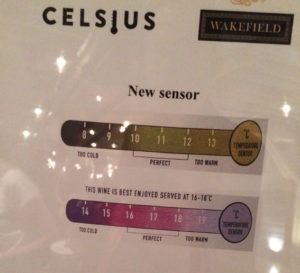 “The proper temperature brings out the balance,” Taylor explains. “We’ve done a lot of work with the international sommelier associations and Masters of Wine and we believe that up to 70-80% of wines served around the world are being served at the wrong temperature—and it just has such an impact on your wines.”
“The proper temperature brings out the balance,” Taylor explains. “We’ve done a lot of work with the international sommelier associations and Masters of Wine and we believe that up to 70-80% of wines served around the world are being served at the wrong temperature—and it just has such an impact on your wines.”
Wakefield is the first winery to draw attention to the importance of serving temperature in enjoying wine through these easy-to-follow labels. While this may be reminiscent of Coors Light’s Cold Activated bottles, which turned its Rocky Mountain icon blue once the beer reached its theoretical optimal drinking temperature, this is a much more precise use of the technology. And the results of our three samplings Thursday—Wakefield’s Estate Chardonnay, Shiraz and Cabernet Sauvignon (each served at two different temperatures—were dramatic.
BIG DIFFERENCE
The fact is, many nuances of aromas and tastes and even textures are lost when your wine is too cold or too warm. Similar to when a wine is corked, the first thing you lose when the temperature is off is the fruit, Taylor explains.
As part of the demonstration, we were each served two glasses of three different wines. One glass was served at its “optimal” temperature. The other glass was served at a non-optimal temperature, albeit a temperature that many are accustomed to.
First up was Wakefield’s 2018 Estate Chardonnay. Served straight from the fridge at 5C, it was notably tight. There was acidity and some fruit, but little beyond that. However, the “optimal” glass, served at 12C, offered much more in the way of floral aromas, as well as a lovely texture and structure, due in no small part to the company’s investment in expensive oak sourced from legendary French merchant and winemaker Louis Latour.
“A decade ago, our Chardonnay had too much malolactic fermentation and too much oak, but we have more fruit now and more subtle oak,” Taylor notes. “We paid a small fortune for that (Louis Latour) oak and the optimal-temperature wine delivers a beautiful, subtle French Oak experience, and the fruit is more balanced against it.”
OVERPOWERING ALCOHOL
Next came the 2018 Estate Shiraz. Served at a summer-warm 26C, it was essentially evaporating alcohol in a glass.
“The alcohol was through the roof on that one,” Taylor notes. “I’m a New World wine person and so I look first for the fruit. But when a wine is too warm, the fruit is the first thing to go, and it’s almost gone here. It’s a completely out-of-whack glass of wine. And the tannins—the glue that keeps a wine together—have also fallen apart. No aromas. Disjointed.”
“There’s no varietal definition,” added Drew Walker of Profile Wine Group, which represents Wakefield in Ontario.
But at the recommended serving temperature of 16C, we encountered a dramatically different red wine, and I could see why it’s one of the top two best-selling premium Shirazes in Australia: a balanced concoction of plums and blackcurrants, accompanied by some lovely aromas of mocha and cedar.
The third and final wine was Wakefield’s 2017 Estate Cabernet Sauvignon. At 26C, it was so flat and devoid of character that I would almost have considered it corked, or at least ‘off’ in some capacity. The 16C glass, on the other hand? That’s where the blackcurrant, cassis and earthiness shone through.
“I think the acidity and tannin held in there a bit (on the warm glass),” Taylor offers. “On the 16C one, though, the aromas are beautiful. Big difference. It’s just the joy of a beautifully balanced glass of wine. The alcohol, aromas, acid and tannin are where we want them to be.”
THE WAY IT WAS MEANT TO BE
It’s a reminder that wines are made, tasted and blended at a cool cellar temperature, and it’s the way they show best, according to the winemaker. “The first thing that got me is how horrendous it is to serve my own family’s wines at the wrong friggin temperature,” Taylor pronounces. “And then you start to think, ‘How much wine have we all drunk throughout our lives at the wrong temperature and didn’t get a great wine experience because of it?
“There’s so much effort from our end to create these beautiful wines, but there are all these variables around the world that are beyond our control that detract from the wine-consuming experience,” Taylor continues. “The (quality and style of) glassware you use, for one. And we’re clearly passionate believers in the screwcap. Name a consumer good that has a seal or packaging that will guarantee that 5-10% of the product will go off. Well, cork delivers that outcome, which is why we moved to screwcap.”
The latest link in the chain of product quality control was the temperature-sensitive back labels, “an initiative from our marketing department back in 2013,” Taylor recalls. “We spent about two years developing the labels. As opposed to the gimmicky nature of the technology used elsewhere in the beverage industry, we decided to take it really seriously and improve the consumer experience. Instead of ‘cold beer,’ we went for ‘optimal drinking temperature.’ A lot of research went into it.”
The technology-packed labels first came to market in 2015 in Australia with Wakefield’s white wines. “We’ve done a lot of work with this concept in Australia since,” Taylor indicates of the labels, which have actually been in Canada for more than a year, but without the marketing narrative behind them. “But now we’re really proactively telling the story,” says Taylor, who expects Wakefield’s next level of wines, their Jamaran series, to adopt the technology soon.
THE 30- to 60-MINUTE RULE
Mass production has been able to keep the production cost of the Optimum Drinking Temperature Sensor to pennies per label, “but when you’re doing hundreds of thousands of cases around the world each year, you’re talking tens of thousands of dollars overall. But we think it’s a great investment,” Taylor observes. “Yes, there is some marketing advantage in telling the story of our brand. But it’s really a consumer communication piece. We just want people to be aware. Get your white wines out of the cooler 30 minutes before you drink them, and put your reds in the cooler for 30-60 minutes before you drink them.”
It initially took some convincing for Taylor himself, but he’s since bought into wine-drinking’s climate-change philosophy. “I remember when our global marketing guy first came to us with this concept,” Taylor reflects. “I said, ‘We’ve been doing this brand for five decades and you want some of the most recognized red wines in Australia to be dropped into a refrigerator before people serve them?’ And he said, ‘Justin, that’s exactly the message I want you and your family to tell around the world.’ And now that I’ve been doing it, it’s absolutely the way to go. Some of our red wines are $200 a bottle, and the Legacy is $1,000 a bottle, and we’re quite prepared for people to put those wines in the refrigerator before they serve them.”
What really does makes Taylor shiver, though? “Watching friends dropping ice cubes into glasses of red wine.”
Now that is downright heresy!
For those interested in the food pairings from our dining experience at The Loft (pictured in the embedded video), here’s what the trio of food & wine pairings consisted of.
First Course: Tarte au Courgette (think “zucchini quiche”), Fontina & Stracciatella Blossom
Paired with Estate Chardonnay 2018 ($16.95)
Served side by side at: Fridge-cold 5 ͦ C and the recommended 12 ͦ C
Main Course: Seared Venison Loin, Celery Root Puree, Morrel, Macerated Blackberry
Paired with Estate Shiraz 2017 ($18.95)
Served side by side at: Room temperature and the recommended 16 ͦ to 18 ͦ C
Dessert: Chèvre Noir, Honeycomb, Cacao Crunch
Paired with Cabernet Sauvignon 2017 ($19.95)
Served Side by side at: Room temperature and the recommended 16 ͦ to 18 ͦ C
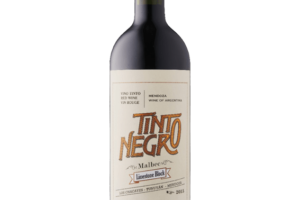
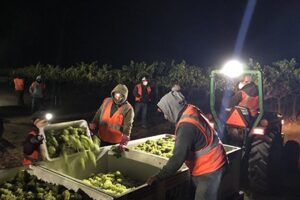
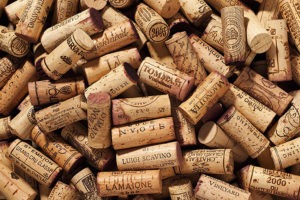
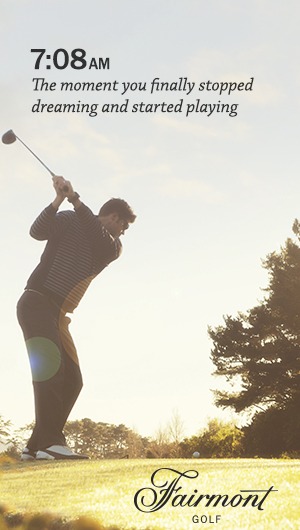
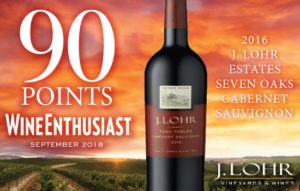
Leave a Reply
Your email is safe with us.